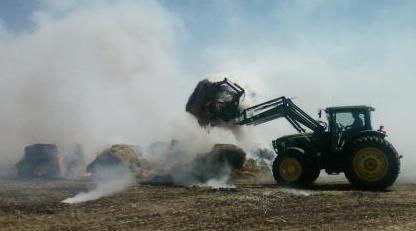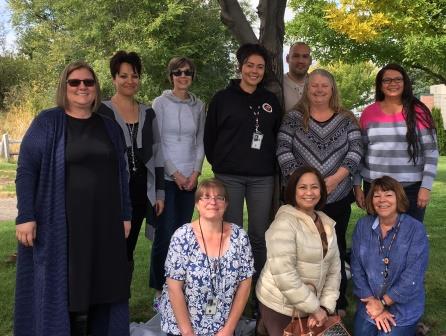You are viewing ARCHIVED content published online before January 20, 2025. Please note that this content is NOT UPDATED, and links may not work. Additionally, any previously issued diversity, equity, inclusion or gender-related guidance on this webpage should be considered rescinded.
Author: Robyn Broyles, Amanda Boatright
During the first week in October, the BIA, Branch of Wildland Fire Management, hosted Fire 101 Training. The training is the first of its kind and is designed to introduce payment team members and regional budget staff to business authorities, agreements, and procurement methods that bind the interagency incident business community together.
Four BIA payment team members from Reston, Virginia and two regional budget staff from Sacramento, California and Minneapolis, Minnesota attended the training at the National Interagency Fire Center, in Boise, Idaho. Attendees gained a better understanding of Incident Business Management, the incident command system and the qualifications that support it.
Instructors led students through a comprehensive and intensive 31+ step process that must occur in order to pay contract vendors who have been hired to help support wildland fires efforts.
Over the course of three intense days, the training provided the foundation necessary to standardize a more efficient fire payment process within the BIA.

Dozer moves burning hay bails during the Torkse Fire, August 2012.
Breaking Ground
BIA payment team members are primarily responsible for ensuring full payment of Equipment Use Invoices submitted when Indian Country uses contracted equipment for fire suppression or repair work. For most students, the training was their first exposure to the wildland fire environment and the interagency community.
Interagency Framework
Lead Instructor, Amanda Boatright, Rocky Mountain Region Fire Program Analyst, is one of BIA’s only qualified Incident Business Advisors. Boatright worked with Aaron Baldwin, Branch Director, Linda Tatum, Branch Budget Planning Director and Robin White, Branch Administrative Officer, to clarify and elaborate on the framework that allows eight different agencies and organizations to partner and provide leadership, policy oversight and coordination to manage the nation’s wildland fire programs – the Service First authority and the Master Interagency Agreement for Wildland Fire Management.
Procurement Processes
Understanding the legal capstones that shape the interagency community provides the tools the students need to fully understand how the BIA supports wildland fire management programs.
Attendees also learned the differences between BIA’s direct service agency programs, Public Law 638-contracted/compacted Tribal programs, and Tribal cooperators. Additionally, students were familiarized with commonly requested types of fire resources (aviation, equipment, crews, overhead, and supply) and the differences in procurement processes for each service BIA provides (direct, contract, or compact).
Agreements
It is crucial to recognize the differences between pre-season incident blanket purchase agreements, including U.S. Forest Service Incident Procurement - Virtual Incident Procurement (VIPR) agreements, and incident-only emergency equipment rental agreements in order to know which department / agency is responsible for payment. These skills are also useful for reconciling payment problems.
Invoices
To avoid payment delays, invoice packages must be completed, fully audited, and approved for payment prior to being sent to Reston, Virginia. In 2017, Reston processed 176 invoices, paying out nearly two million dollars to contracted vendors. Its important BIA makes these payments as quickly as possible since many vendors depend on this revenue for their livelihood.
To emphasize the detail required to process a payment, students were required to create an Equipment Use Invoice, a process that entails more than 31 detailed steps.
Benefits of Training
By cross-training each other in internal business processes and systems, payment team members and budget staff are working closer together to improve cost effectiveness while strengthening coast to coast relationships.
For payment team members, creating a payment package in training demonstrated the extensive “behind the scenes” work that occurs prior to an invoice making it to their desk for payment. For regional budget staff, the lessons validated the important role they play in ensuring invoices are complete and accurate prior to submitting them to payment team members in Reston.
The training also offers an opportunity to recruit new employees interested in developing incident business qualification that are critically needed in Indian Country
Looking Ahead
Payment teams and budget staff are working on codifying standard practices in a Fire Payment Guide to ensure consistent and quality products. They are also looking to host future Fire 101 classes later in 2018.
| Direct Service (BIA) | Self-Determination (Contract) | Self-Governance (Compacts) Tribes | |
| Definition of Service | Wildland fire protection and program management services are directly provided by the BIA, typically via a local BIA Agency Office. Sometimes they are provided by the regional office. | P.L.93-638 allows Tribes to have greater autonomy and the opportunity to assume responsibility for programs and services administers to them on behalf of the Secretary of the Interior through contractual agreements. An individual Tribe may contract all or portions of the wildland fire program, with the BIA providing technical assistance to the Tribe when requested. | The Tribal Self Governance Act of 1994 furthered opportunities for self-determination by allowing a Tribe to compact (assume) all BIA functions at the Agency. The DOI Office of Self-Governance (OSG) administers Tribal Self-Governance, with additional oversight and technical assistance by the BIA regional offices. |
| Funding Pathway | The Branch provides funding to Regions who then sub-allocate to Agencies. | Branch provides funding to regions. They then allocate to Tribes through a self-determination contract. | The Branch provides funding to the Office of Self Governance, who then provides to the Tribes. |



